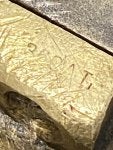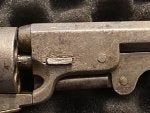Your barrel address was used by Colt from about 101000 to 215000 which matches your serial. The lever latch on yours is the thick style, used from 165000 to 215000, again correct for your revolvers serial. Same with the barrel lug (thick style, 165000 to 215000). From 118500 to 215000 there was, on most frames, a milled groove called a 'cap slot' going through the recoil shield, visible on the right side of the frame. Does yours have this? In addition the recoil shield cut out on the right is 1/8" smaller than serials before 118500 so height of the cutout should be around 0.812" from top to bottom at the widest. Lets see what else....hammer knurling should be the 'loose' type and not have a border. Your trigger guard is the large rounded type correct for 85000 to 215000. As I stated above yours looks original. No cylinder scene to me is not an indication of originality or not. The scene was often weakly rolled on and wears away fast, although the serial number is almost always still visible. The font of the serials I do see looks correct. The grips were almost always 1 piece grips. Did yours crack into 2 and someone used a screw? When you have them apart can you tell if it was originally a one piece grip? I get most of my info from Swayze's book. He states that ".36 cal." was always stamped on the trigger guard on the left side after serial 140000. Use a magnifier on yours to see if any trace survived the beating that took place on the brass there. Inspectors initial or numbers were not found on any Navy's after serial 194000.
Hope this helps. There are fixable issues with your Navy. The screw head for the loading lever should be on the left side. Is there a serial on the loading lever? If the grips are originally one piece I would glue them back together and try to fill the hole if you are good at that kind of stuff (match the grain direction, color, etc). A replacement wedge can be fitted, maybe not advisable since the current one is patina'd to the gun. My only concern would be the cylinder...is a serial there? Even if a replacement it has certainly been with the gun awhile since the patina matches the rest of the gun.
Does everything cycle and is it timed well?
I do not think it is a Brevet or imitation at all. Brevets were authorized by Colt and thus they had no reason to exactly use the same roll marks etc., and in fact I cannot recall seeing a brevet that did. Imitations on the other hand never did the exact job the way Colt did.....you see this in funny shaped triggerguards and goofy grips and odd barrel lugs and funny barrel to grip angles. If I saw your gun at a gun show, based solely on the photos you provided, I would not question its originality except maybe the cylinder. Thats my 2 cents worth in any case, and probably what my opinion would bring!!! I certainly am no expert by any means, I just love 51 Navy's (and 1866 Winchesters) and look at every single one I run across.
If you can post a few photos of the right side and use a magnifier on the TG (and on the cylinder too for a trace of a serial).




















